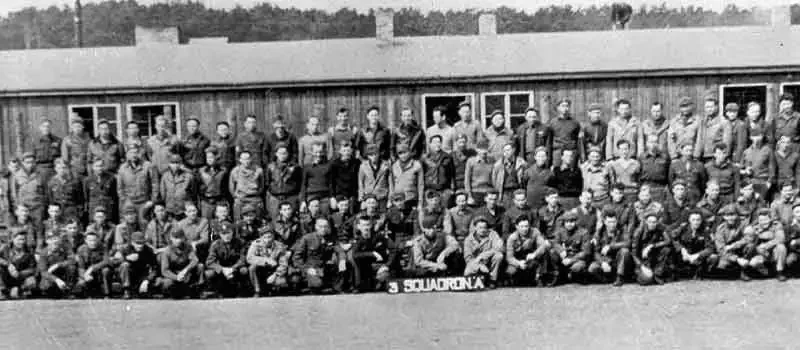- Military History
- Prisons, Prisoners & Camps
- Stories
- Arbeitskommandos - Work Detachments of POW (1939)

Arbeitskommandos - Work Detachments of POW (1939) The Work detachments established during World War II by the German Army
During World War II, the German army established work detachments, or Arbeitskommandos, to detain prisoners of war who were put to work in factories, farms, mines, and other industries. Under the terms of the 1929 Geneva Convention (Articles 27 to 34), countries at war were permitted to utilize the labor of prisoners of war so long as that labor was not directly related to the production of war materials.
Officers could not be forced to work but could be given supervisory jobs, if they so requested. Noncommissioned officers could be forced to do supervisory work, unless they requested regular work for pay. The majority of POWs, being private soldiers, had no choice but to work for pay and were placed in Arbeitskommandos for this purpose.
Arbeitskommandos were administrative subunits of the main POW camps, but because they were often located away from the main camps and closer to the places of work, they often functioned with a considerable degree of independence. As it was difficult for neutral inspectors and delegates of the International Committee of the Red Cross (ICRC) to visit all the work detachments, conditions were, in many cases, substandard.
The prisoners of an Arbeitskommando usually elected a leader, known as the Man of Confidence, whose duties included ensuring that the food rations were regular, clothing stocks were sufficient, medical attention was adequate, and the work being assigned was not directly related to the war effort. In the event of complaints or queries, the Man of Confidence would contact his counterpart at the main prison camp, who would take the matter up with the German commandant and, if necessary, with the neutral authorities or the ICRC.
Although the POWs were effectively leased to a company or factory, they remained under the disciplinary authority of the German military guards who supervised them. As the war progressed and Germany's economic circumstances became more desperate, the military assigned a new responsibility to these guards: In addition to ensuring that the prisoners obeyed the lawful requests of their employers, the guards were also required to ensure that they worked as hard as possible. In some cases, the material conditions under which the prisoners worked or lived were so bad that they threatened illegal strikes.
Because the requirement to work carried the weight of a military order, refusal to work was legally considered mutiny. Consequently, the German guards were permitted to force the prisoners to work at gunpoint, if necessary. If the prisoners' behavior was too unruly, they could be arrested and charged with disciplinary infractions. Nevertheless, threats of mutiny as a result of poor working or living situations did occur, and some Arbeitskommandos faced virtual starvation in the final chaotic year of the war.
Conditions were bad for American and British Commonwealth POWs, but at least they were rarely forced to labor in industries that produced war materials. French, Polish, and especially Russian prisoners fared considerably worse. The German government employed them directly in war-related work, such as in munitions factories or the construction and maintenance of military installations.
The Arbeitskommandos for Soviet POWs, furthermore, were run as slave-labor camps, with conditions sometimes on a par with those in concentration camps. The use of these prisoners of war in illegal labor was considered a war crime at the postwar Nuremberg Trials; Arbeitskommandos were the vehicle for the commission of this crime.

A US Army M4 Sherman tank of the 47th Tank Battalion, 14th Armored Division, crashes through the fence of Stalag XIII-B on the 6th of April 1945. Stalag 13 (or Stalag XIII C) was on the outskirts of Hammelburg, about 50 miles (80 km) east of Frankfurt, Germany.
The majority of POWs in camps in Europe had long periods during which conditions were bearable and when they made good use of their time. With amazing improvisation for which captivity was the stimulus, many were able to lead a vigorous and intellectual life. By summer 1942, for example, prisoners had got life at Lamsdorf pretty well organized. Enough supplies of Red Cross food, and private clothing and tobacco parcels arrived regularly. The medical supplies were adequate. Here, half a barrack was set aside as a church, the other half serving as the camp school. There were vegetable and flower gardens and facilities for football, cricket, and all-in wrestling.
All these other activities did not prevent much attention being devoted to escaping. There were many attempts, both from permanent and work camps. Men tried to walk out of camps disguised in German uniforms or tried to leave hidden in some form of transport. There was much tunneling activity. Many camps had escape organizations, with escape officers. Here, all escape activity was coordinated, with the officers taking turns to warn of the approach of the German guards.
These "escape routes", permitted many men to reach Allied territory. A series of mass breakouts in 1944 culminated in that from Stalag Luft III in March 1944, when 76 POWs escaped through tunnels. Three reached England, a few got to Danzig, but the majority were recaptured. Fifty of these were shot in the back by the Gestapo.
- {{#owner}}
- {{#url}} {{#avatarSrc}}
{{name}} {{/url}} {{^url}} {{#avatar}} {{& avatar}} {{/avatar}} {{name}} {{/url}} - {{/owner}} {{#created}}
- {{created}} {{/created}}























